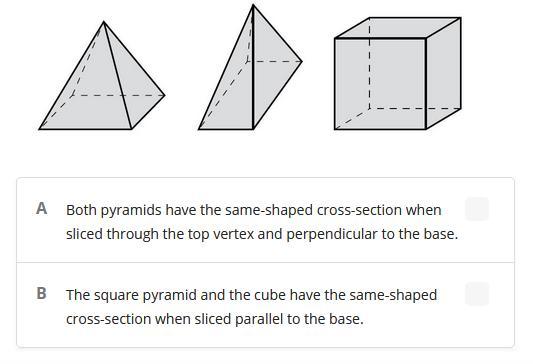Consider the possible cross-sections of a square pyramid, a rectangular pyramid, and a cube.
Which of the following statements are true?
Choose both answers.
Geometry

Answers
Answer: B
Step-by-step explanation: B because if you slice the cross-section of a square pyramid parallel to its base, you would get a square. The same thing is true for the cube. A is not true because the triangles are not similar.
Answer:
b
Step-by-step explanation:
Related Questions
PLZZZ HELP ME GIVING 20 POINTTSSSS
Answers
Answer:4/5
Step-by-step explanation:
I think it's 4/5 because the number 3 is only one number of 5. And if you subtract 5-1, you'll get 4.
An irregular figure was broken into a triangle and rectangle.
The area of the triangle is
in2.
The area of the rectangle is
in2.
The area of the irregular figure is
in2.
Answers
Step-by-step explanation:
The area of the triangle is, 8×6/2 = 24 in²
The area of the rectangle is, 8×4=32 in²
The area of the irregular figure is,
(24+32) in²
= 56 in²
Answered by GAUTHMATH
In which step does a mistake first occur?
(24 ÷ 3 + 10) - 14 ÷ 2
Step 1. (8 + 10) - 14 ÷ 2
Step 2. 18 - 14 ÷ 2
Step 3. 4 ÷ 2
Step 4. 2
Answers
Answer:
Step 3. 4 ÷ 2
Step 4. 2
these two steps are wrong
[tex](24 ÷ 3 + 10) - 14 ÷ 2[/tex]
[tex] (8 + 10) - 14 ÷ 2[/tex]
[tex] (8 + 10) - 7[/tex]
[tex]18 - 7[/tex]
[tex]11[/tex]
Note : See the explanation and get the answer
The eggs of birds and other animals come in many different shapes and sizes. Eggs often have a shape that is nearly spherical. When this is true, you can use the formula for a sphere to find their volume.
Fossilized spherical eggs of dinosaurs called titanosaurus sauropods were found in Patagonia. These eggs were 11 centimeters in diameter. Find the volume of an egg. Round your answer to the nearest tenth.
Answers
Answer:
696.9 cm^3 to the nearest tenth.
Step-by-step explanation:
Radius of the egg = 1/2 * 11 = 5.5 cm.
Volume = 4/3 * pi * 5.5^3
= 696.9099703
is 2/3(3/4x-3/2) equal to 1/2x -1
Answers
Answer:
Step-by-step explanation:
that would be the anwer
Answer: yes
Step-by-step explanation:
2/3(3/4x-3/2)
reduce the numbers and get
1/2x-1
A rhombus has sides 10 cm long and an angle of 60°. Find the diagonals of the rhombus.
Answers
Since all the sides are equal, the altitude is
10 sin60° = 5√3
To see this, draw the rhombus ABCD and drop an altitude from D to AB. Now you have a right triangle with hypotenuse=10 and base angle=60°
What is the x-coordinate of the solution to the system of equations shown below?
y-2x=4
3x-5y=15
a. -6
b. -5
c. 5/3
d. 5
Answers
What does asmr mean!?
Answers
Answer:
Autonomous sensory meridian response
Step-by-step explanation:
pretty much it is just a reaction you would have based on hearing or feeling something
Evaluate the following expression.
12÷4×32+(4−2)5
Answers
Answer:
answer is 111
Step-by-step explanation:
Answer:
Answer:12÷4×32+(4−2)5 = 106
This is the right Answer for your question :3
I hope you are having a great day ❤️❤️❤️❤️
What sequence of transformations, when applied to △ABC , shows that △ABC is similar to △ A ′ B ′ C ′ ? dilation with respect to the origin by a scale factor of 2 followed by a translation of 2 units left dilation with respect to the origin by a scale factor of 1 2 followed by a translation of 2 units right translation of 2 units right followed by a dilation with respect to the origin by a scale factor of 1 2 translation of 2 units left followed by a dilation with respect to the origin by a scale factor of 1 2
Answers
Answer:
The correct sequence of transformations that shows that △ABC is similar to △A′B′C′ is:
translation of 2 units left followed by a dilation with respect to the origin by a scale factor of 12.
Step-by-step explanation:
A point, line, or geometric figure can be transformed in one of four ways, each of which affects the shape and/or location of the object.
In this case, we can see that a dilation with respect to the origin by a scale factor of 12 would stretch or shrink the triangle, but would not change the angles.
Therefore, we need to apply a translation first to move the triangle into the correct position.
So, we first translate the triangle 2 units left, which does not change its shape or size, but moves it to a position where it can be more easily compared to the other triangle.
Then, we apply a dilation with respect to the origin by a scale factor of 12, which stretches or shrinks the triangle but does not change its shape.